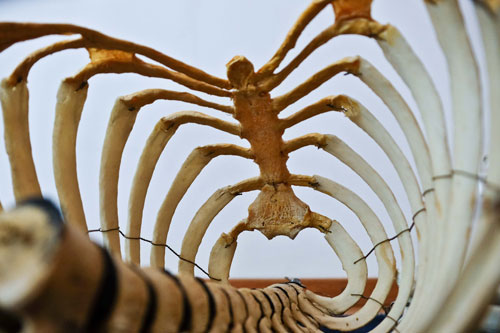Have you ever seen your GP or physiotherapist whilst suffering from low back pain? In which case you should have been asked some seemingly random questions about how your bladder and bowels were functioning to make sure you weren’t suffering from Cauda Equina Syndrome – want to know what it is? Continue reading!
As experienced chartered physiotherapists at Western House Consulting Rooms in Barnsley, a crucial part of the role we play in assessing and treating people who come to see us is identifying when people need to be referred on for additional investigations (tests such as an x-ray or MRI scan) or care.
As physiotherapists if we aren’t happy with something you’re presenting with or telling us and we want a second opinion we make sure that we point you in the right direction armed with all the information to help you in the best possible way.
Although we do see serious conditions in clinic, thankfully these are very infrequent and our team are highly trained to screen for any worrying signs or symptoms. One such rare condition that our physiotherapists are taught to screen for in all patients presenting with back pain is Cauda Equina Syndrome.
What is Cauda Equina Syndrome?
Inside your vertebral column (or backbone/spine) passes your spinal cord which extends from your brain downwards inside a special bony canal. The spinal cord carries messages from the brain to the rest of the body. It also carries messages or sensations from the rest of the body back to the brain. At each level of the spine, the spinal cord gives off branches or pairs of nerves (known as nerve roots). These are the nerves that are responsible for sending these signals to and from the muscles and other structures throughout your body.
The spinal cord ends just above your waist and below this is a group of nerves called the Cauda Equina (which is a Latin term meaning “horse’s tail” as this is how the bundle of nerves fan-out). The nerves of the cauda equina supply the muscles that control the bladder, bowel, genitals and the legs. Cauda Equina Syndrome is the symptoms that occur as a result of the nerves of the Cauda Equina becoming trapped or squashed.
What causes Cauda Equina Syndrome?
The cauda equina lies in the spinal canal behind the discs in the lower or lumbar part of the spine. These discs sit between the vertebra (bones in your back) but can sometimes rupture (known as large disc prolapse). This can happen quite suddenly, usually in younger people. When this happens the nerves of the cauda equina become compressed. In older people, it may happen gradually and be combined with other degenerative (or arthritic) changes within the spine, commonly spinal stenosis (narrowing of the bony spinal canal). The effects may be noticed more slowly, and even regarded as simply part of “getting old”.
It is important to point out at this stage that not all disc prolapses (or “slipped discs” as you may have heard them called) lead to ruptures and cauda equina syndrome. In the same way that arthritic changes in our spine are as normal as “going grey or getting wrinkles” and again don’t always lead to symptoms of either back pain or cauda equina syndrome. The figures suggest that cauda equina syndrome comprises of only 2-6% of lumbar disc operations. Less common causes of cauda equina syndrome include tumours, infection or trauma.
How is it diagnosed?
Initially, your physiotherapist at Western House may suspect a diagnosis of Cauda Equina Syndrome from the information you tell them during your assessment. Your answers to any specific questions and the examination findings give your physiotherapist an indication of how urgently the problem needs to be investigated.
Treatment
If Cauda Equina Syndrome is suspected your physiotherapist will give you further information on what to do next- don’t be alarmed if this includes a visit to A&E for a scan and further tests. Urgent spinal surgery is required to prevent permanent damage to the nerves which supply the bladder and bowel.
Symptoms
Cauda Equina Syndrome presents as one or a combination of the following symptoms. Commonly these symptoms develop suddenly and may worsen rapidly, within hours or days. However, some people develop symptoms gradually. IT IS STRONGLY RECOMMENDED THAT IF YOU DEVELOP ANY OF THE FOLLOWING SYMPTOMS THAT YOU SEEK URGENT MEDICAL ADVICE FROM YOUR GP OR A&E DEPARTMENT.
- Saddle anaesthesia
- Loss of feeling between your legs where a horse’s saddle may fit.
- Numbness around your back passage and/or genitals
- The altered feeling when using toilet paper to wipe yourself
- Disturbances to your bladder
- Inability to urinate (pass water)
- Difficulty initiating urination (urinary hesitation)
- Loss of sensation when you pass urine
- Inability to stop or control your flow of urine (incontinence)
- Loss of the full bladder sensation (not knowing when your bladder is either full or empty)
- Leaking urine or recent need to use pads
- Bowel disturbance
- Inability to stop a bowel movement or leaking (incontinence)
- Constipation
- Loss of sensation when passing a bowel motion
- Sexual problems
- Inability to achieve an erection or ejaculate
- Loss of sensation in the genitals during intercourse
The advice given in this blog is not designed to replace proper medical advice by either your physiotherapist or GP. Remember any combination or number of the warning signs could be symptoms of Cauda Equina Syndrome and seek emergency medical help.
For further advice or to book an appointment to see one of our Barnsley based physiotherapists at Western House Consulting Rooms Ltd please contact us on (01226) 730249.









